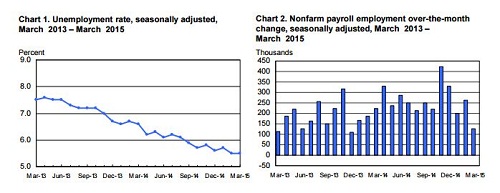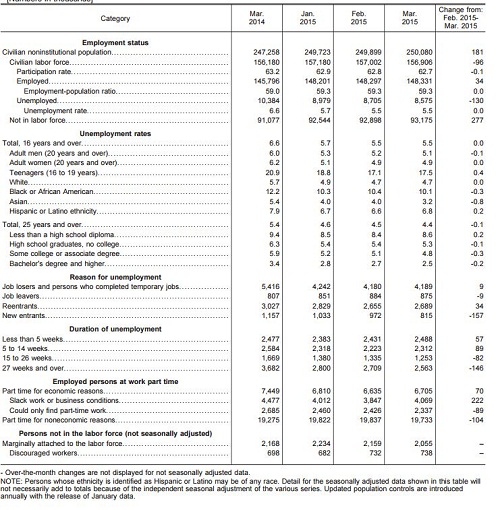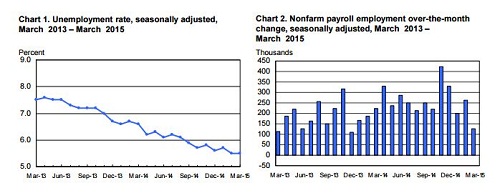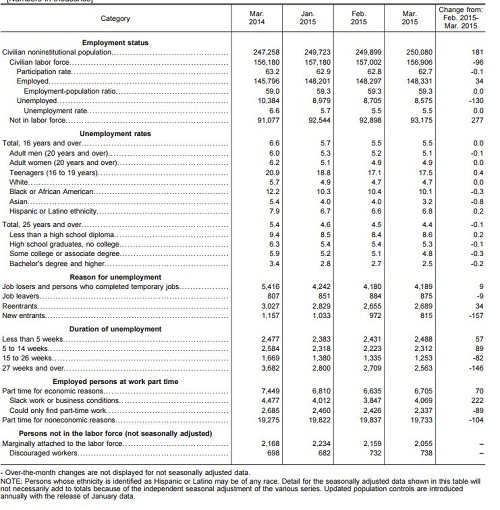 이미지 확대보기
이미지 확대보기고용 쇼크의 진앙은 미국 노동부가 발표한 신규고용지수였다. 노동부는 지난 주말 3월의 신규고용이 12만6000개였다고 발표했다. 시장이 전망한 24만5000개의 절반에도 미치지 못한 것이다.
미국의 신규고용은 2014년 2월 이후 단 한 달의 예외도 없이 매달 20만개 이상을 기록해왔다. 한 달에 20만 명 이상이 신규로 취업을 해 왔던 것이다.
바로 이 고용지수 때문에 미국의 경기가 호황기로 접어들었다는 진단이 나왔다. 미국 연준(FRB)이 기준금리인상의 카드를 만지작거리게 된 1차적인 요인도 고용지수에 있다. 매월 20만개 이상씩 신규고용이 생겨나자 ‘경기 과열론’이 제기됐다. 적정수준 이상으로 달아오른 경기를 누그러뜨리기 위해 금리를 인상할 수밖에 없다는 ‘금리인상불가피론’이 대세로 굳어져가고 있었다.
그동안 미국 정부는 매달 평균 26만9000개씩의 새로운 일자리가 생겨야만 견실한 경제기조를 이어갈 수 있다는 입장이었다. 여기에 비한다면 3월의 12만6000개는 아주 부진한 성적이다.
전문가들은 미국 신규고용의 수가 큰 폭으로 감소한 이유를 달러강세에서 찾고 있다. 달러화가 너무 빠른 속도로 올라 기업들에 부담을 주면서 신규일자리 증가세가 꺾였다는 지적이다. 블룸버그는 ‘신규고용의 감소는 강한 달러에 대한 경고이자 금리인상 시도에 대한 경고'라고 진단했다.
이런 점에서 미국 연준이 추진해왔던 기준금리인상이 차질을 빚을 가능성이 높아졌다. 돈의 값인 금리를 인상하면 달러는 그 인상폭만큼 추가로 강세압력을 받게 된다. 미국 연준으로서는 금리인상으로 경제를 망쳤다는 원성을 감내하기가 어려운 실정이다. 바로 이 같은 이유로 ‘6월 인상’은 물론 ‘9월 인상’도 어려울 것이라는 전망이 나오고 있다. 3월뿐만 아니라 앞으로 4월 이후에도 계속 신규고용의 수가 줄어든다면 당분간 금리인상이 아예 유보될 수도 있을 것이다.
한 달치의 신규고용지수만으로 고용시장의 추세적 악화를 단정하는 것은 무리일 수 있다. 적어도 두서너 달은 더 지켜보아야 할 것이다. 페레스 미국 노동부 장관도 고용상황이 아직은 견실하다는 성명을 발표하기도 했다.(페레즈 노동장관 성명 전문 첨부)
문제는 고용지표뿐 아니라 다른 거시경제지표도 동반 추락하고 있다는 사실이다. 한 나라의 경제상황을 판단하는 중심지표인 경제성장률 전망도 상당히 비관적이다. 1%에 못 미치는 0%대에 그칠 것이라는 전망이 이어지고 있는 것이다. 불과 한 달 전까지만 3% 내외의 성장을 장담해왔던 분위기에 비한다면 실망스러운 수준이라고 하지 않을 수 없다.
미국 경제의 예상 밖 부진에 선제적으로 대응하는 지혜가 요구되는 시점이다.
 이미지 확대보기
이미지 확대보기[미국 노동부의 3월 신규고용 발표전문]
THE EMPLOYMENT SITUATION -- MARCH 2015
Total nonfarm payroll employment increased by 126,000 in March, and the unemployment rate was unchanged at 5.5 percent, the U.S. Bureau of Labor Statistics reported today. Employment continued to trend up in professional and business services, health care, and retail trade, while mining lost jobs.
Household Survey Data
In March, the unemployment rate held at 5.5 percent, and the number of unemployed persons was little changed at 8.6 million. Over the year, the unemployment rate and the number of unemployed persons were down by 1.1 percentage points and 1.8 million,
respectively.
Among the major worker groups, the unemployment rates for adult men (5.1 percent), adult women (4.9 percent), teenagers (17.5 percent), whites (4.7 percent), blacks (10.1 percent), Asians (3.2 percent), and Hispanics (6.8 percent) showed little or no change in March.
Among the unemployed, the number of new entrants decreased by 157,000 in March and is down by 342,000 over the year. Unemployed new entrants are those who never previously worked.
The number of long-term unemployed (those jobless for 27 weeks or more) was little changed at 2.6 million in March. These individuals accounted for 29.8 percent of the unemployed. Over the past 12 months, the number of long-term unemployed has declined by 1.1 million.
The civilian labor force participation rate was little changed at 62.7 percent in
March. Since April 2014, the participation rate has remained within a narrow range of 62.7 percent to 62.9 percent. In March, the employment-population ratio was 59.3 percent for the third consecutive month.
The number of persons employed part time for economic reasons (sometimes referred to as involuntary part-time workers) was little changed in March at 6.7 million. These individuals, who would have preferred full-time employment, were working part time because their hours had been cut back or because they were unable to find a full-time job.
In March, 2.1 million persons were marginally attached to the labor force, little
changed from a year earlier. (The data are not seasonally adjusted.) These individuals were not in the labor force, wanted and were available for work, and had looked for a job sometime in the prior 12 months. They were not counted as unemployed because they had not searched for work in the 4 weeks preceding the survey.
Among the marginally attached, there were 738,000 discouraged workers in March, little different from a year earlier. (The data are not seasonally adjusted.) Discouraged workers are persons not currently looking for work because they believe no jobs are available for them. The remaining 1.3 million persons marginally attached to the labor force in March had not searched for work for reasons such as school attendance or family responsibilities.
Total nonfarm payroll employment increased in March (+126,000). Over the prior 12 months, employment growth had averaged 269,000 per month. In March, employment continued to trend up in professional and business services, health care, and retail trade, while employment in mining declined.
Employment in professional and business services trended up in March (+40,000). Job growth in the first quarter of 2015 averaged 34,000 per month in this industry, below the average monthly gain of 59,000 in 2014. Within professional and business services, employment continued to trend up in architectural and engineering services (+4,000), computer systems design and related services (+4,000), and management and technical consulting services (+4,000).
Health care continued to add jobs in March (+22,000). Over the year, health care has added 363,000 jobs. In March, job gains occurred in ambulatory health care services (+19,000) and hospitals (+8,000), while nursing care facilities lost jobs (-6,000).
In March, employment in retail trade continued to trend up (+26,000), in line with its prior 12-month average gain. Within retail trade, general merchandise stores added 11,000 jobs in March.
Employment in mining declined by 11,000 in March. The industry has lost 30,000 jobs thus far in 2015, after adding 41,000 jobs in 2014. The employment declines in the first quarter of 2015, as well as the gains in 2014, were concentrated in support activities for mining, which includes support for oil and gas extraction.
Employment in food services and drinking places changed little in March (+9,000),
following a large increase in the prior month (+66,000). Job growth in the first
quarter of 2015 averaged 33,000 per month, the same as the average monthly gain
in 2014.
Employment in other major industries, including construction, manufacturing, wholesale trade, transportation and warehousing, information, financial activities, and government, showed little change over the month.
In March, the average workweek for all employees on private nonfarm payrolls declined by 0.1 hour to 34.5 hours. The manufacturing workweek decreased by 0.1 hour to 40.9 hours, and factory overtime remained at 3.4 hours. The average workweek for production and nonsupervisory employees on private nonfarm payrolls decreased by 0.1 hour to 33.7 hours.
In March, average hourly earnings for all employees on private nonfarm payrolls rose by 7 cents to $24.86. Over the year, average hourly earnings have risen by 2.1 percent. Average hourly earnings of private-sector production and nonsupervisory employees rose by 4 cents to $20.86 in March.
The change in total nonfarm payroll employment for January was revised from +239,000 to +201,000, and the change for February was revised from +295,000 to +264,000. With these revisions, employment gains in January and February combined were 69,000 less than previously reported. Over the past 3 months, job gains have averaged 197,000 per month.
 이미지 확대보기
이미지 확대보기[미국 페레즈 노동장관 신규고용 담화 전문]
Statement of US Labor Secretary Perez on March employment numbers
WASHINGTON ? U.S. Secretary of Labor Thomas E. Perez issued the following statement about the March 2015 Employment Situation report released today:
"The economy added 126,000 new jobs in March (129,000 in the private sector), extending the longest streak of private sector job growth on record to 61 consecutive months, with 12.1 million jobs created over that time.
The unemployment rate held steady at 5.5 percent. Long-term unemployment fell to 1.6 percent, down 0.7 percentage points from a year ago. Average hourly earnings increased by 7 cents for all private-sector employees, contributing to a 2.1 percent increase in nominal hourly wages over the last 12 months.
"While March's numbers aren't as robust as we've seen over the last year, overall trends remain solid, and there is every reason to be optimistic about our economic trajectory going forward. We've made incredible strides since the depths of the Great Recession, but there's more work to do to make sure every person can benefit from this recovery. There's more to do to strengthen and grow our middle class.
"The Obama administration continues to make strong investments that will give people the in-demand skills required to succeed in 21st century jobs; by contrast, the Congressional majority's budget would mean 2.2 million fewer people in 2016 alone receiving job training and employment services. A new public-private initiative called TechHire is giving Americans pathways to well-paying IT jobs, which are currently available in the hundreds of thousands. And today, the president is announcing new steps to drive growth in clean energy and train 75,000 workers, including many veterans, for solar jobs.
"Wage growth remains the unfinished business of this recovery. While Wall Street employees are collectively taking home billions of dollars just in bonuses, minimum wage workers haven't had a raise since 2009. Even as many states and localities take action on this issue, we still need Congress to put partisanship aside and raise the federal wage floor.
"And to help working families, we also need to expand access to paid leave, so that no one has to lose a paycheck in order to take care of a sick child or spouse. This week we kicked off a nationwide tour ? Lead on Leave: Empowering Working Families Across America ? to highlight best practices from employers and state and local governments, raising awareness about the need nationwide for paid leave and other flexible workplace policies.
"These steps are essential to an agenda based on middle-class economics, where everyone has the chance to succeed. As we celebrate the progress of the last few years, we have to do more to ensure the rising tide lifts every boat. Working together, we can do more to expand opportunity and create an economy that works for everyone."
 이미지 확대보기
이미지 확대보기김대호 경제연구소 소장 tiger8280@























![[뉴욕증시] 美·EU 무역협상 난항에 혼조세](https://nimage.g-enews.com/phpwas/restmb_setimgmake.php?w=270&h=173&m=1&simg=2025071905245702748be84d87674118221120199.jpg)





















